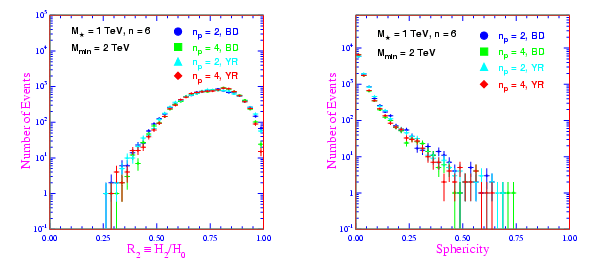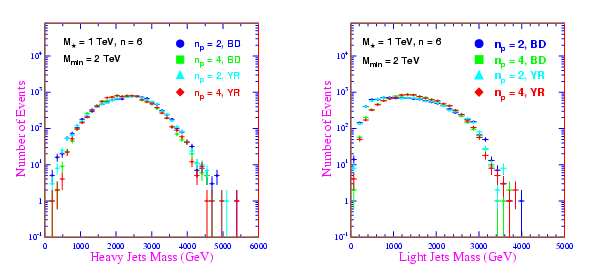A brief introduction to the CATFISH Monte Carlo generator
CATFISH (Collider grAviTational FIeld Simulator for black Holes) is a Fortran Monte Carlo program to simulate TeV black hole
production at CERN's Large Hadron
Collider.
The fundamental scale of gravity may be much lower than the measured gravitational scale. In scenarios with large or warped extra
dimensions, the observed weakness of gravity is explained by assuming that standard model fields are constrained to propagate on a
four-dimensional submanifold, whereas gravitons propagate in the higher-dimensional spacetime. If the gravitational coupling constant
is of the order of few TeVs, super-Planckian events at CERN's LHC could lead to the formation of subnuclear black holes and
branes.
The semiclassical Hawking effect provides a thermal decay mechanism for black holes, thus allowing their detection. Under the most
favorable circumstances, the black hole event rate at the LHC should be comparable to the ttbar event rate.
Until now, numerical studies of observational signatures have used Monte Carlo generators implementing the semiclassical picture
outlined above. Currently, there are two generators for black hole production at particle colliders: TRUENOIR and CHARYBDIS. However,
recent results have modified significantly our understanding of black hole formation and evolution. CATFISH deals with the
observational signatures of black hole events beyond the simple semiclassical model by including many of the accepted theoretical
results in the literature. The generator, called CATFISH, interfaces to the PYTHIA Monte Carlo fragmentation code. Generators with similar characteristics of
CATFISH have already been successfully utilized to simulate black hole production in ultrahigh-energy cosmic ray air showers and in lepton
colliders such as the muon collider.
Basics of black hole formation and evolution
Thorne's hoop conjecture states that an event horizon forms when a mass is compacted into a region with circumference smaller than
twice its Schwarzschild radius in any direction. At the LHC, this process can be achieved by scattering two partons ij with
sufficiently large center-of-mass energy and sufficiently small impact parameter. The black hole event is described by the inelastic
process ij → black hole + E(X), where E(X) is the collisional energy that does not fall beyond the event horizon. Due to the
gravitational nature of the process, this energy includes mainly a bulk component of gravitational radiation, although non-standard
model gauge fields and a brane component of standard model fields cannot be excluded. If E(X) = 0, the hoop conjecture implies
that the parton cross section for black hole production is equal to the geometrical black disk cross section. If E(X) ≠ 0, the cross
section is generally smaller and depends on the impact parameter. This treatment is valid only if the black hole is larger
than the Compton length of the colliding quanta.
The hoop conjecture has been tested by different methods, the most popular one being the trapped-surface approach, which gives a
bound on the inelasticity by modelling the incoming partons as two Aichelburg-Sexl shock waves. The Aichelburg-Sexl wave is obtained
by boosting the Schwarzschild solution to the speed of light at fixed energy. The resulting metric describes a plane-fronted
gravitational shock wave corresponding to the Lorentz-contracted longitudinal gravitational field. The parton scattering is simulated
by superposing two shock waves travelling in opposite directions. The union of these shock waves defines a closed trapped surface that
allows to set a lower bound on the initial black hole mass. The collisional energy loss depends on the impact parameter and increases
as the number of spacetime dimensions increases. The black hole mass monotonically decreases with the impact parameter from a maximum
of about 60-70% of the center-of-mass energy for head-on collisions.
The trapped-surface result is consistent within one order of magnitude with the hoop conjecture. However, this approach neglects mass,
spin, charge and finite-size effects of the incoming partons. Even with these limitations, the trapped-surface model provides only a lower bound on
the black hole mass. Independent estimates of the gravitational collisional energy loss are possible through alternative approaches.
The gravitational energy emission in a hard instantaneous collision can be evaluated in the linearized limit. This computation
suggests that the trapped-surface method overestimates the gravitational energy emitted in the process. For head-on collisions, the
instantaneous method predicts that the gravitational energy loss is only about 10% of the center-of-mass energy. This result is in
agreement with perturbative calculations modelling the parton-parton collision as a plunge of a relativistic test particle into a
black hole with mass equal to the center-of-mass energy.
The total cross section for a super-Planckian black hole event involving two nucleons is obtained by integrating the parton cross
section over the parton distribution functions. The PDFs are not known at energies above the TeV and for values of momentum transfer
expected in black hole formation. The total cross section is usually calculated by imposing a cut-off at these values. The PDFs also
suffer from uncertainties at any momentum transfer and the definition of the momentum transfer of about 10% and 20%, respectively.
The lower cutoff on the fraction of the nucleon momentum carried by the partons is set by the minimum-allowed formation mass of the
gravitational object. This threshold is usually considered to be roughly equal to the minimum mass for which the semiclassical
description of the black hole is valid.

Figure I: CATFISH plot of sphericity and second Fox-Wolfram momentum for 10000 ten-dimensional black hole events at the
LHC (Black disk and Trapped-Surface models). The final black hole decay produces either two (np=2) or four (np=4) quanta. The fundamental
Planck mass is 1 TeV. (Plot by R. Godang.)
It is believed that the decay of microscopic black holes happens in four distinct stages: I. radiation of excess multipole moments
(balding phase); II. spin-down; III. Hawking evaporation; IV. final explosion or formation of a black hole remnant.
Although some progress has been made, a quantitative description of the balding phase and the spin-down phase is not fully known. For
example, the emission of radiation from a higher-dimensional rotating black hole on the brane is not known for spin-2 fields. Balding
and spin-down effects could play an important role in black hole phenomenology at the LHC.
Field emissivities for all standard model fields have recently been calculated. For non-rotating black holes and the minimal SU(3) x
SU(2) x U(1) standard model, most of the black hole mass is radiated as standard model quanta on the brane, although the
gravitational emission in the bulk cannot be neglected for high dimensions. However, (i) it is not clear what is the effect of
rotation on black hole emissivities; (ii) the field content at trans-Planckian energies is not known. Onset of supersymmetry, for
example, could lead to other evaporation channels and large emission of undetectable non-standard model quanta during the decay phase
even in absence of rotation.
Quantum gravitational effects and black hole recoil could also affect the emission of visible quanta on the brane. An example of
quantum gravitational effects are corrections to the Hawking thermodynamics due to the existence of a minimum length of the order of
the Planck length. This is a common consequence of most (if not all) theories of quantum gravity such as string theory,
non-commutative geometry, canonical quantum gravity, etc. The presence of a cutoff at the Planck scale leads to a modification of the
uncertainty principle. Since the Hawking thermodynamical quantities can be derived by applying the uncertainty principle to the black
hole, the existence of a minimum length leads to corrections in the thermodynamical quantities.

Figure II: CATFISH plot of heavy and light jet mass for 10000 ten-dimensional black hole events at the LHC (Black disk and
Trapped-Surface models). The final black hole decay produces either two (np=2) or four (np=4) quanta. The
fundamental Planck mass is 1 TeV. (Plot by R. Godang.)
At the end of the Hawking phase, the black hole is expected to either non-thermally decay in a number of hard quanta or leave a
remnant. In either case, the lack of a theory of quantum gravity does not allow to go beyond a phenomenological treatment. The final
decay is usually described by setting a cutoff on the black hole mass of the order of the Planck mass and equally distributing its
energy to a number of quanta. Since the decay is non-thermal, and in absence of any guidance from a theory of quantum gravity, the
quanta are democratically chosen among the standard model degrees of freedom.
References
- M. Cavaglià, R. Godang, L. Cremaldi and D. Summers, CATFISH: A Monte Carlo simulator for black
holes at the LHC, Comput.Phys.Commun.177:506-517,2007 arXiv:hep-ph/0609001
M. Cavaglià, Black hole and brane production in TeV gravity: A review, Int. J. Mod. Phys. A 18, 1843 (2003) [arXiv:hep-ph/0210296]
- A.Roy and M.Cavaglià, Discriminating Supersymmetry and Black Holes at the Large Hadron Collider, Phys. Rev. D 77, 064029 (2008) [arXiv:hep-ph/0801.3281]
- G. Landsberg, Black holes at future colliders and beyond, J.Phys.G32:R337-R365,2006 [arXiv:hep-ph/0607297]
- R. Emparan, Black hole production at a TeV, Invited talk at 12th Workshop on General Relativity and Gravitation
(JGRG 12), Tokyo, Japan, 25-28 Nov 2002 [arXiv:hep-ph/0302226]
- P. Kanti, Black holes in theories with large extra dimensions: A review, Int. J. Mod. Phys. A 19, 4899 (2004) [arXiv:hep-ph/0402168]
- S. Hossenfelder, What black holes can teach us, Published in in 'Focus on Black Hole Research', pp. 155-192, Nova Science Publishers, 2005 [arXiv:hep-ph/0412265]
- V. Cardoso, E. Berti and M. Cavaglià, What we (don't) know about black hole formation in high-energy collisions,
Class. Quant. Grav. 22, L61 (2005) [arXiv:hep-ph/0505125]
- R. Godang et al., Resolution of nearly mass degenerate Higgs bosons and production of black
hole systems of known mass at a muon collider, Int. J. Mod. Phys. A 20, 3409 (2005) [arXiv:hep-ph/0411248].

